

JavaScript Iterables vs Iterators
source link: https://blog.bitsrc.io/javascript-iterables-vs-iterators-009162379a15
Go to the source link to view the article. You can view the picture content, updated content and better typesetting reading experience. If the link is broken, please click the button below to view the snapshot at that time.
JavaScript Iterables vs Iterators
Differences and Similarities Between JavaScript Iterables and Iterators
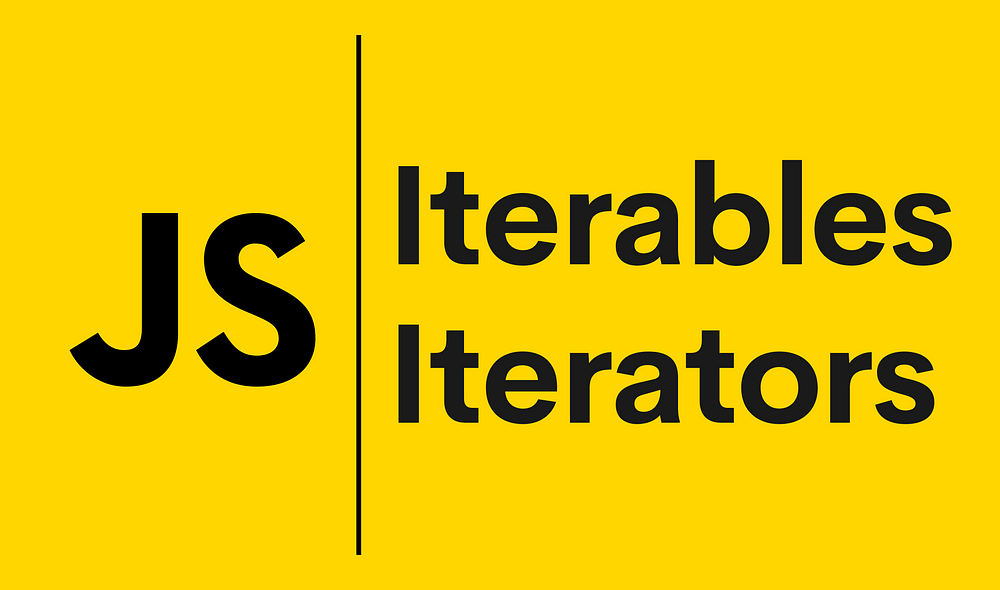
Iterables and Iterators are two essential concepts every developer should know when working with lists of items like arrays or strings.
You can loop over an iterable, like a list of numbers. An iterator is a tool that helps you go through each item in this list individually.
Understanding these concepts is crucial because they are everywhere in JavaScript. Whenever you want to go through a list of items, you’re likely to use these concepts. They make your code cleaner and easier to understand, especially when dealing with large or complex data structures.
Understanding Iterables
JavaScript iterable is an object that can be looped over or traversed sequentially.
To be considered an iterable, an object must adhere to the Iterable Protocol (a set of rules that allows an object to be iterable). This is a fundamental concept in JavaScript since many common operations in JavaScript, like loops, work with iterable objects.
Characteristics of Iterables
- Iterable Protocol: An iterable must adhere to the Iterable Protocol, which requires a
[[Symbol.iterator]](https://developer.mozilla.org/en-US/docs/Web/JavaScript/Reference/Global_Objects/Symbol/iterator)method. This special function equips the object with the ability to iterate. When an object has[Symbol.iterator], it signals to JavaScript how its elements can be accessed sequentially.
let myArray = [1, 2, 3];
if (typeof myArray[Symbol.iterator] === 'function') {
console.log("myArray is iterable!"); // This will log because arrays are iterable by default
}
- Sequential Access: Iterables provide sequential access to their elements, which means you can access elements in the order they are stored.
let characters = 'hello';
for (let char of characters) {
console.log(char); // Logs 'h', 'e', 'l', 'l', 'o' in order
}
- Versatility in Usage: Iterables can be used with several JavaScript constructs that expect a sequence of values, such as for…of loops, spread syntax (…), destructuring, and more.
// for...of
let numbers = [1, 2, 3];
for (let number of numbers) {
console.log(number); // 1, 2, 3
}
// spread
let set = new Set([4, 5, 6]);
let combinedArray = [...numbers, ...set]; // Combines arrays: [1, 2, 3, 4, 5, 6]
// destructuring
let [first, second] = numbers;
console.log(first, second); // 1, 2
- Customizability: You can create custom iterables by defining how the iteration will occur. Custom iterables offer a high control over what values are iterated over and how.
let myIterable = {
from: 1,
to: 5,
[Symbol.iterator]() {
return {
current: this.from,
last: this.to,
next() {
if (this.current <= this.last) {
return { done: false, value: this.current++ };
} else {
return { done: true };
}
}
};
}
};
for (let value of myIterable) {
console.log(value); // Outputs 1, 2, 3, 4, 5
}Common Examples of Iterables
Many everyday structures in JavaScript are iterables, often used without realizing their technical classification as such. These iterables range from simple arrays to complex data structures, each offering unique ways to access and manipulate their elements.
- Arrays — The most commonly used iterables. You can loop over every element in an array in the order they appear.
let fruits = ["apple", "banana", "cherry"];
for (let fruit of fruits) {
console.log(fruit); // Outputs "apple", "banana", "cherry"
}
- Strings — A string is an iterable of its characters. You can iterate over each character in a string.
let greeting = "Hello";
for (let char of greeting) {
console.log(char); // Outputs "H", "e", "l", "l", "o"
}
- Maps — Maps are key-value pairs and are iterable. You can iterate through the entries, keys, or values.
let map = new Map([['a', 1], ['b', 2], ['c', 3]]);
for (let [key, value] of map) {
console.log(${key}: ${value} ); // Outputs "a: 1", "b: 2", "c: 3"
}
- Sets — Sets are collections of unique values. Like arrays, you can iterate over the elements of a set in the order they are stored.
let uniqueNumbers = new Set([1, 2, 3]);
for (let number of uniqueNumbers) {
console.log(number); // Outputs "1", "2", "3"
}
- NodeList — NodeList objects are collections of nodes, often returned by methods like document.querySelectorAll. They are iterable, allowing you to loop over each node.
let divs = document.querySelectorAll('div'); // Selects all <div> elements
for (let div of divs) {
console.log(div); // Outputs each <div> element
}Understanding Iterators
An iterator in JavaScript is an object that facilitates the process of iteration, specifically by accessing elements in a collection one at a time. It’s a concept closely related to iterables but with a distinct role in the iteration process.
Iterators have a method named next(). When you use next(), it gives you the next item from the collection you're going through. Each time you get an item, it comes as a small object with two parts: value, which is the actual item, and, done, a true/false flag that tells you if you've reached the end of the collection.
Characteristics of Iterators
- Next Method — The
next()method is the core of an iterator. Each call tonext()moves to the next element.
let arrayIterator = [1, 2, 3][Symbol.iterator]();
console.log(arrayIterator.next().value); // Outputs 1
- Stateful Iteration — Iterators remember their current position, allowing iteration to be paused and resumed.
console.log(arrayIterator.next().value); // Outputs 2 (continuing from the previous state)
- Standardized Interface — Iterators follow a predictable pattern, making them consistent across different types. Whether you’re using an iterator on a set, an array, or another type of collection, you use the same method,
next(), to get each item.
let setIterator = new Set(['a', 'b', 'c']).values();
console.log(setIterator.next().value); // Outputs 'a'
- Direct Interaction — Iterators provide more control over the iteration process through direct interactions. Instead of automatically going through every item (like in a loop), you decide when to move to the next item and can even pause in between.
let stringIterator = 'hello'[Symbol.iterator]();
console.log(stringIterator.next().value); // Outputs 'h'
Common Examples of Iterators
In JavaScript, iterators are often derived from common iterable structures:
- Array Iterators — You can use its iterator to iterate over an array manually. The iterator lets you access each element one at a time.
let numbers = [1, 2, 3];
let numbersIterator = numbers[Symbol.iterator]();
console.log(numbersIterator.next().value); // Outputs 1
- String Iterators — A string iterator gives you each character one by one when requested.
let greeting = "Hello";
let greetingIterator = greeting[Symbol.iterator]();
console.log(greetingIterator.next().value); // Outputs 'H'
- Map and Set Iterators — They provide iterators to access elements individually, offering key-value (Map) or value-only (Set) iteration.
let set = new Set(['a', 'b', 'c']);
let setIterator = set[Symbol.iterator]();
console.log(setIterator.next().value); // Outputs 'a'
- NodeList Iterators — Using an iterator on a NodeList allows you to access individual nodes.
let divs = document.querySelectorAll('div');
let divsIterator = divs[Symbol.iterator]();
console.log(divsIterator.next().value); // Outputs the first <div> elementThe Relationship Between Iterables and Iterators
JavaScript iterables and iterators are closely linked concepts, each playing a distinct but complementary role in handling and traversing data.
- Iterables Are Like Collections: Any object you can loop through is an iterable. Examples include arrays, strings, sets, and maps. These are like collections of items that you can look through.
- Iterators Are Like Guides: An iterator is a special helper for an iterable. Its job is to take you through each item in the iterable, one at a time. It knows which item comes next and tells you when you’ve seen them.
When you want to start going through an iterable, you ask it for an iterator. You do this by calling a special function on the iterable, [Symbol.iterator](). This function sets up and gives you the iterator.
Let’s look at an example with an array (an iterable) and see how we get its iterator:
let myArray = [10, 20, 30]; // This is an iterable (an array)
let myIterator = myArray[Symbol.iterator](); // Getting an iterator from the array
console.log(myIterator.next().value); // Outputs 10 (the first item)
console.log(myIterator.next().value); // Outputs 20 (the next item)
In this example, myArray is the iterable (the collection), and myIterator is the iterator (the guide). When we call myArray[Symbol.iterator](), we get myIterator, which then lets us access each item in myArray one by one using its next() method.
Similarities and Differences
Similarities:
- Both are part of the iteration process in JavaScript.
- They work together to provide a way to access elements in a collection.
Differences:
- Iterables represent the collection itself (e.g., an array or string), while iterators are tools for accessing the elements of these collections.
- You loop over an iterable (using for…of, etc.), but you manually invoke next() on an iterator to access elements.
- An iterable just needs to have the
[Symbol.iterator]method. An iterator, on the other hand, must have thenext()method, and it maintains the state of iteration.
Best Practices in Using Iterables and Iterators
Using iterables and iterators efficiently is crucial for writing clean and efficient JavaScript code. Here are some best practices and scenarios where they are particularly beneficial:
1. Leverage ES6 Features
Modern JavaScript (ES6 and later) offers enhanced syntax and features for working with iterables and iterators, such as for…of loops, spread syntax, and generator functions. Utilize these features to write more concise and readable code.
let numbers = [1, 2, 3];
for (let number of numbers) {
console.log(number); // More readable loop syntax
}
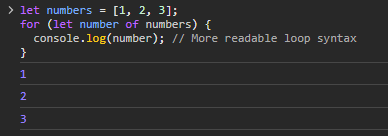
2. Lazy Evaluation with Iterators
When you need to process elements on-demand, iterators are the ideal choice. This approach, called lazy evaluation, helps optimize performance significantly. It’s especially useful for large or computationally expensive datasets, as it processes items as needed rather than all at once.
function* fibonacci() {
let [a, b] = [0, 1];
while (true) {
yield a;
[a, b] = [b, a + b];
}
}
let fibSequence = fibonacci();
console.log(fibSequence.next().value); // Outputs 0
console.log(fibSequence.next().value); // Outputs 1
// Can be continued as needed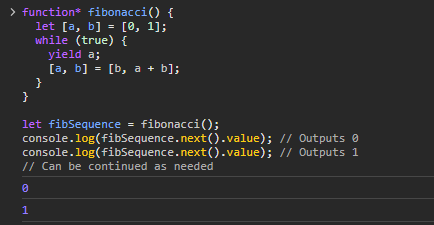
3. Error Handling
Always consider error handling while iterating. For instance, when creating custom iterators, ensure they handle potential errors in data processing, like missing elements or broken data structures.
// Sample processData function
function processData(item) {
if (typeof item !== 'number') {
throw new Error('Invalid item: not a number');
}
// Some processing logic here
return item * 2; // Example operation
}
// Generator function for data iteration with error handling
function* dataIterator(data) {
for (let item of data) {
try {
yield processData(item);
} catch (error) {
console.error(Error processing item ${item}: , error.message);
// Handle the error as needed:
// Option 1: Skip the item
continue;
// Option 2: Yield a default value (uncomment if needed)
// yield defaultValue;
}
}
}
// Example usage with a dataset
const someDataset = [1, 2, 'invalid', 4]; // Ensure this variable is unique in the scope
for (let processed of dataIterator(someDataset)) {
console.log(processed); // Will process valid items and handle errors
}
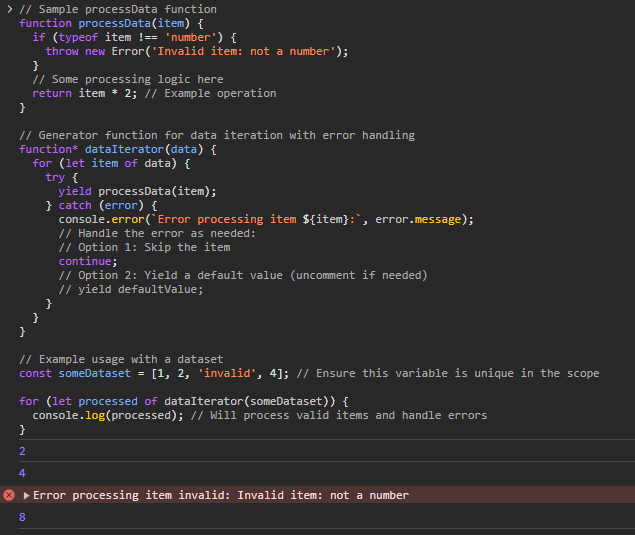
4. Avoid Modifying Collections While Iterating
Modifying a collection (like adding or removing elements) while iterating over it can lead to unexpected behavior or errors. It’s generally a good practice to avoid altering the collection during iteration.
let numbers = [1, 2, 3, 4, 5];
for (let number of numbers) {
console.log(number);
// Avoid doing something like numbers.push(6) here pop or splice
}
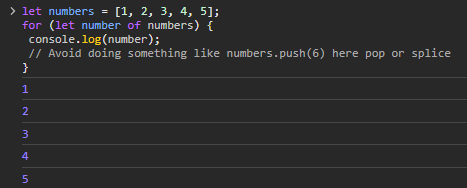
let numbers = [1, 2, 3, 4, 5];
for (let number of numbers) {
console.log(number);
if (number == 4){
numbers.splice(number)
}
}
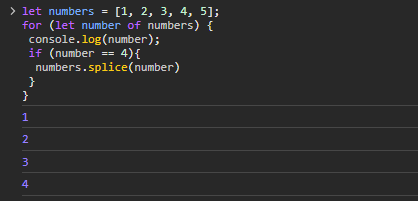
5. Minimize Operations in Loops
When using iterables in loops, keep the code inside the loop as lean as possible. Minimizing operations in each iteration can significantly improve performance and cost.
// High-Cost Operation: Math.pow
console.time('High-Cost Operation Loop');
let highCostSum = 0;
for (let num of numbers) {
highCostSum += Math.pow(num, 2); // Higher cost operation
}
console.timeEnd('High-Cost Operation Loop');
// Lower-Cost Operation: Simple Addition
console.time('Lower-Cost Operation Loop');
let lowCostSum = 0;
for (let num of numbers) {
lowCostSum += num + 2; // Lower cost operation
}
console.timeEnd('Lower-Cost Operation Loop');
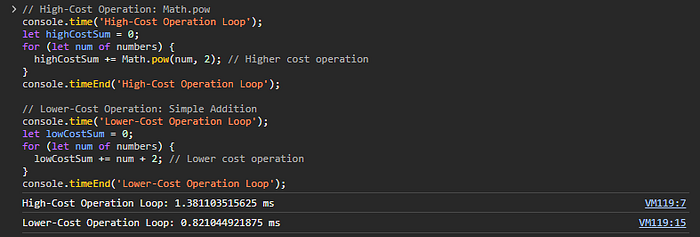
6. Handle Large Datasets with Iterators
When dealing with large datasets like a text file with thousands of lines, loading the entire file into memory can be inefficient.
In such situations, iterators, particularly generator functions, provide an efficient solution by processing data in chunks or on-demand.
// Simulated function to mimic reading lines from a file
function simulateReadNextLine(file) {
let currentLine = 0;
return () => {
if (currentLine < file.length) {
return file[currentLine++]; // Return the next line
} else {
return null; // No more lines
}
};
}
// Sample function to process a line
function processLine(line) {
// Perform some processing on the line
return Processed: ${line} ;
}
// Generator function to process a large dataset
function* processLargeDataset(file) {
const readNextLine = simulateReadNextLine(file);
let line;
while ((line = readNextLine()) !== null) {
yield processLine(line); // Yield the processed line
}
}
// Example usage
const largeFile = ["Line 1", "Line 2", "Line 3", /* ... more lines ... */];
for (let processedLine of processLargeDataset(largeFile)) {
console.log(processedLine); // Handle each processed line
}
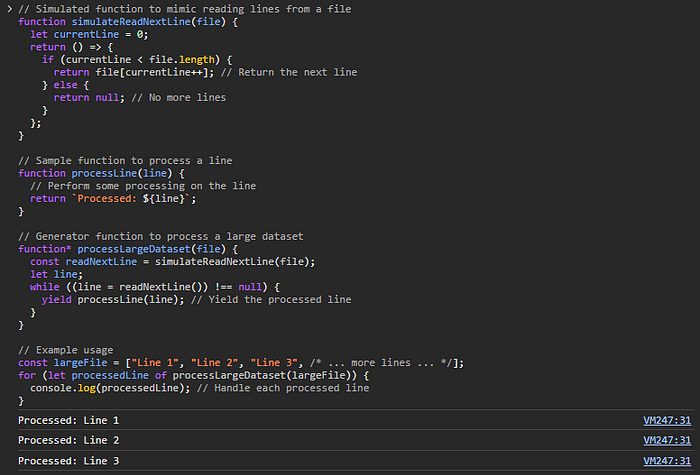
In this example:
simulateReadNextLineis a function that simulates reading a line from a large file.processLineis where you would put the logic to process each line.- processLargeDataset is a generator function that processes each line one at a time, yielding processed lines.
- The
for...ofloop iterates over the processed lines, handling them one by one without loading the entire file into memory.
Conclusion
Iterables and iterators plays a crucial role in JavaScript data handling. They offer the flexibility to work with various data structures, from simple arrays to complex custom types. By understanding and applying these concepts, you can write more efficient, readable, and maintainable JavaScript code.
I hope you found this article helpful.
Thank you for reading.
Recommend
About Joyk
Aggregate valuable and interesting links.
Joyk means Joy of geeK